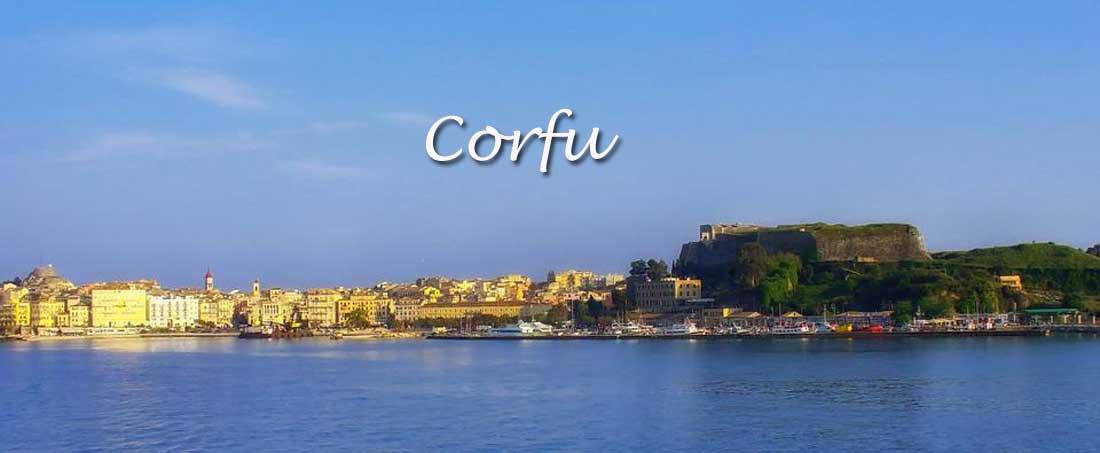Corfu, information and visitors guide
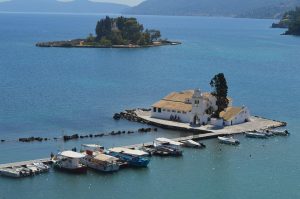 Corfu is one of best loved Greek holiday islands and a major target of British tour companies offering bargain beach holiday deals in the Greek island. Called Kerkyra in Greek, Corfu is the greenest of the Ionian islands thanks to some very heavy rains over the winter.
Corfu is one of best loved Greek holiday islands and a major target of British tour companies offering bargain beach holiday deals in the Greek island. Called Kerkyra in Greek, Corfu is the greenest of the Ionian islands thanks to some very heavy rains over the winter.
Corfu boasts a great number of sandy beaches and some lively resorts. Most of the bigger beach resorts lie on the north and east coasts but, away from the crowded strips, visitors can seek out more relaxed resorts, while inland hill villages are a step back in time.
Corfu is proud of its cultural and artistic heritage made immediately visible in its many fine museums and its warmly welcoming Italianate architecture.
Mountains dominate the northern half of Corfu where dramatic cliffs drop to the island’s most popular beach resorts. Holiday hotspots are concentrated around Corfu Town in the east and along the island’s north coast at resorts like Sidari and Roda.
The dense vegetation, the countryside full of cypress and olive trees, the dozens of beaches, which are formed along 217 kilometers of coastline, the picturesque medieval and Venetian villages of the hinterland, enchant and conquer the visitor, offering him all the modern comforts, but also the charm and traditions of past times.
Tour the Old Town and its cantonments adorned with household laundries, visit the historic churches and discover hidden squares among the high-rise Venetian apartment buildings, climb the Old Fortress to see the grandeur of the city from above and finally enjoy a coffee your in Liston, a point of reference and sociability for locals and visitors.
In the interior of the island, Nature rages. Unique beauties and attractions await travelers, such as Lake Korission, with its 14 different species of orchids on its sandy shores, and the mountain massif of Pantokrator to the north.
Just off the north-west coast of Corfu, three small paradises, the Diapontia Islands, far from the bustling crowd, stand out for their quiet and special way of life, being a very good alternative for those looking for peace and quiet on their holidays.
Corfu with its meadow in Ropa, its valley in the area of Lefkimmi, the lake of Korissia offers many emotions to those who love nature.
Corfu is a magical place from end to end, a great work of art that reveals itself more and more the more you see it. Whether you are in a modern tourist resort, or in the most isolated village, the charm of this island will be forever etched in your memory.
About Corfu
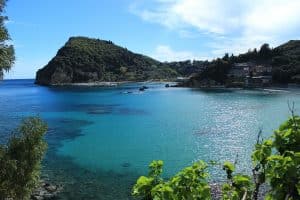
This is largely true for much of Corfu island where beautiful bays of golden sand and pretty fishing villages have been overrun with cheap hotels and happy-hour karaoke bars.
It must be admitted, Corfu was once an embarrassing byword for bar-crawling British lager-louts on bargain booze holidays.
Fortunately, large parts of Corfu escaped the worst of the Brit invasions and some of the loveliest beaches and most romantic villages in the Greek islands can still be found here.
The most popular holiday hotspots are concentrated in the resorts that surround Corfu Town and along the island’s north coast.
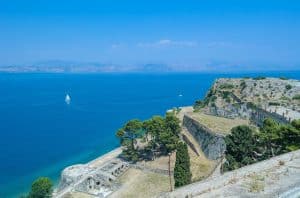
Whatever holiday you prefer there are plenty to be found online these days. Corfu is also a popular destination for independent travelers and cheap rooms are found everywhere.
Corfu has been a popular Greek Island holiday destination for many years. It lies off the north-west coast of Greece in the Ionian island group.
Corfu has the shortest flight time from Europe to any Greek island . There are domestic flights to Athens and Thessaloniki but the vast majority of traffic is in summer charter flights from Europe, most of which arrive on Monday and Friday.
Corfu is also a major port of call for ferries, notably from Italy, calling in on the way to the mainland port of Patras. Some independent holidaymakers opt for cut-price flights to Italy and a fast ferry to Corfu.
Roads are generally good, especially in the heavily populated north but lanes can be poorly maintiang in the hilly interior.
Corfu is a big island and journey times can be longer than visitors think, especially in the hilly north where steep, twisting roads can lead to slower speeds.
Corfu has historical and archaeological interest, tourist infrastructure, a historic city-jewel but also dozens of traditional villages and the well-known Ionian landscape, wonderful beaches with crystal clear waters against a green background, it is a separate chapter of Greek and international tourism and attracts a wide range of travelers.
The Old Town with the old and the new fortress, a UNESCO World Heritage Site, is at the center of interest: buildings of rare beauty and architectural value, Spianada Square with the Liston, the great arched portico, the endless walks in the cantons and Campiello district, in Mon Repo and Achilleio.
With interesting museums and churches as well as a distinct cultural tradition, with its philharmonics to measure. And when darkness falls, the pulse of entertainment beats in the bars of the Eftia street but also in the neighborhood in the new fortress.
To the north dominates the mountain of Pantokrator, while the landscape is completed by the inland villages, both alive and abandoned and picturesque fishing villages that have developed into tourist resorts, but also lagoons – important ecosystems.
As for accommodation, the options cover every taste (especially in the summer months): from historic hotels and romantic boutique hotels in the city, simple rooms for rent, independent maisonettes or luxury hotel units by the sea to private accommodation in a private village with stone houses but and traditional farm houses.
The islands saint, Agios Spyridon, is kept in a silver casket in the sixteenth century church. He was a bishop who lived on Cyprus in the third century and is still believed to perform miracles. Reports of seaweed being found on the saints feet in the morning make many people believe he walks around at night, maybe visiting his fiend St. Gerasimos on Cephalonia.
The Easter celebration here is a little different, since it is a custom to break ceramic pots on Good Friday. You have to watch out – people are throwing the pots from their balconies everywhere.
Geoography
Corfu is long (about 62 km long), narrow (average width about 9.5 km) and runs almost parallel to the mainland coast. Its width in the northern part reaches about 28 km, while it narrows towards the south (narrowest point 3.5 km). Between Corfu and the mainland coast stretches the almost closed Corfu Sea. The latter is very narrow in its northern part (where the North Strait of Corfu is formed, about 2 km wide) and wider in the southern part, where the South Corfu Strait is formed, about 10 km wide.
On the western side of the island stretches the open sea of the Ionian Sea. Due to its wavy form during most of the year, it rushes onto the land and erodes it (marine erosion), resulting in the western coasts of Corfu being steep and rugged, a fact that makes fishing and transportation difficult. Only in the northern part are the gulfs of Agios Georgios and Liapades. Read more about the geography of Corfu
Mythology
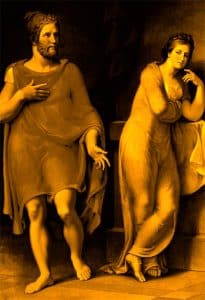
We also find it with the name Drepanon or Drepani, from its similarity to the shape of a sickle. Homer in his writings gives the island the name Sheria. It is the island off whose shores the wave brought the shipwrecked Odysseus. There, Nausicaa, the daughter of King Alcinous, found him sleeping exhausted and carried him to the palace where the hospitable Phaeacians offered him their hospitality and finally led him back to his Ithaca ending his wanderings.
During the Byzantine era, the island was called Korifos after the two-peaked Acropolis, which was located on the site of the current city. From a paraphrase of this name came the Latin address Corfu by which Corfu is known today all over the world.
History
Corfu is identified by most archaeologists with the mythical island of the Phaeacians. Here Homer placed, according to those who accept the identification of Sheria with Corfu, the penultimate station that the resourceful Odysseus arrived shipwrecked. The ancient Corfu people boasted that they were descended from the mythical Phaeacians, Nausicaa and King Alcinous, to the point that they named their war port, “Alkinous Port”. Until today, despite the efforts of great archaeologists such as Dorpfeld and Bulle, the palace of Alkinoos and the Mycenaean Sheria have not been found, although Mycenaean installations were found on the western beach of the island.
Apollonius of Rhodes is also mentioned in the Phaeacians in the Argonauts, where Jason and the Argonauts found refuge on the island of Alcinous and Aretis. There, in the cave of Makrida, Jason and Medea were married.
Mythology handed over the current emblem of the city to the younger Corfu people. “Apidalos Naus” still remains a symbol of the nautical skill of the Phaeacians. In addition to the Homeric name Sheria, in the philological sources we also find various other names, such as Drepani or Harpi, Makri, Kassopaia, Argos, Keraunia, Phaeakia, Korkyra or Corfu (Doric), Gorgo or Gorgyra and much later the medieval names Koryfo or Korfoi, due to the two characteristic top rocks of the Old Fortress of Corfu.
In 1815 the British were the regents of Corfu and they stayed for almost 50 years. The Italians occupied the island in 1923 and 1941. Corfu was bombarded by the Germans and the Allies during World War IIThe island was never conquered by the Turks. In stead, the Venetians ruled here, which of course has influenced both the culture, architecture and language. The island became part of Greece in 1864 after being ruled by other nations as well: French, Russian and British. Read more about the History of Corfu
Corfu culture and customs
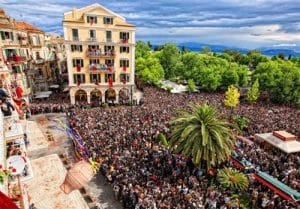
The special singsong accent, the inexhaustible zest for celebration and dancing, the optimism, the warm and true humanity that represents Greek values, the rich business activity with respect for cultural heritage and the natural environment, the deep religious faith that is evident from the numerous churches and monasteries that exist everywhere on the island, simplicity, grace and harmony are all elements that make up the physiognomy of the locals who were lucky enough not to experience the Turkish occupation that deprived the rest of Greece of the opportunity to develop for four whole centuries.
More than six months of the year, Corfu lives at the intense pace of the tourist peak. The colorful crowd – which exceeds the local population – floods the hotels, shops, restaurants, bars, discotheques, casino in search of entertainment and entertainment day and night. The people of Corfu are turning from quiet farmers into active cosmopolitans.
The season starts as early as Easter, which is celebrated with great splendor and expresses the deepest religious feeling of the inhabitants. Spectacular are the celebrations held in honor of the island’s patron saint, Saint Spyridon, accompanied by a philharmonic orchestra from all over the island.
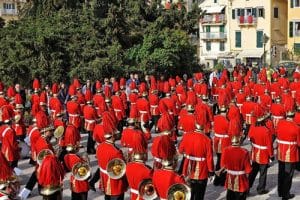
This veneration of the saint shows that the inhabitants really believe that they are under his protection – he is their own saint! In August, the celebration organized after the doxology at the church of St. Spyridon is particularly brilliant.
There is a re-enactment of the episode of the rebellion, then there is the famous barcarola, a parade of boats from which folk bards sing traditional songs with guitars and fully decorated floating platforms with various performances inspired by the imagination and the traditions of the island and local dancers who dance aboard to the sounds of songs. The sweet melodies and the beautiful spectacle gather a crowd along the harbor. The end of the parade is followed by spectacular fireworks that light up the August Corfu sky with thousands of colors. Agricultural work such as harvesting, harvesting or everyday activities such as fishing also give cause for celebration. On New Year’s, according to a local custom, strangers are offered basil sprouts as a sign of friendship and hospitality.
Local religious festivals
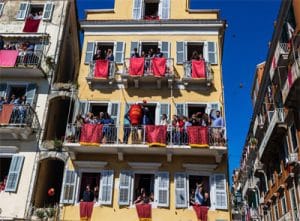
Also, many festivals are organized in honor of various saints such as the Friday of Diakainisimo (Zoodochou Pigi) in Paleokastritsa, Analipsi, in the Analipsi area and Argirades, on May 8 and on August 15 (Assumption of the Virgin Mary) in Kassiopi, on July 8 (Agios Prokopios) in Kavo Lefkimmis and Agios Prokopios, on July 20 (Prophet Ilias) in Magoulades, on August 6 (Transfiguration of the Savior) in Pontikonisi and Agios Mattheos and a six-day Pilgrimage to the top of Pantokrator, on August 23 (Our Lady of Odegetrias) in Gastouri, Pelekas and Agios Deka and finally, on September 8 in the village of Afra. There, the musical tradition of the inhabitants comes to life with the dominant instruments being the guitar and the violin, which accompany lyrics in the Heptanisian dialect and often incoherent Italian words.
Music and theater
Music and theater find fertile ground to develop in Venetian-occupied Corfu, and at the beginning of the 17th century the theater of San Giacomo is created, marking the beginning of an era of rich artistic creation. Particularly theater-loving, the people of Corfu organized performances in houses and squares even during the siege of the city by the Russian-Turkish fleet.
Today performances are given in the Municipal Theater as well as in the two fortresses by various cultural institutions and artists. The Italian lyric theater left its mark on musical education and tradition, while the ground was also fertile for the development of literature with the poet Dionysios Solomos as the main representative. The first Greek philharmonic was created here in 1840 by Nikos Mantzaros, a composer who composed Solomos’ “Hymn to Freedom”.
In all the events that are accompanied by dancing, one can admire couples in impressive dance figures that with their lively steps, graceful twists and happy rhythm convey a feeling of optimism to the viewer. The local women’s attire is characterized by vibrant bright colors, embroidered aprons, rich jewelry, colorful waist scarves and the famous head scarves that are adorned with large beautiful flowers.
What to see in Corfu
Corfu Town
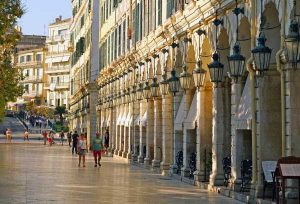
This is a large town of 40,000 dominated by double forts. The 13th century Neo Frourio (New Fort), with its dungeons and impressive turret battlements, is far more interesting than the older 6th century Paleo Frourio (Old Fort).
The focal point of Corfu Town is the Spianada, a public square and park – one of the biggest in Europe – where evening crowds can take a stroll as children play. Bizarrely, there is an English cricket field where matches are still played.
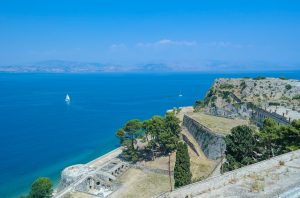
To really see the beauty of the island you should rent a car and go to some of the pretty villages and deserted beaches.
For example, you should visit Sidari, Aharavi, Dasia, Ypsos, the channel of love, the fishing villages Benitses, Moraitika etc.. From Kassiopi you can see Albania if the weather is clear enough.
If you want a taste of the cosmopolitan side of Corfu, you can visit the most popular square Spianada in the town for a coffee or a drink.
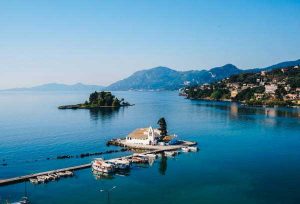
On a cliff just by the most popular beach, Paleocastritsa, there is a 13th century monastery, which holds the huge bones of a whale. At Kalami you can see the house of Lawrence Durell.
As well as beach activities such as jet-skis, water-skiing, windsurfing and scuba-diving there is golf, horse-riding, mountain biking inland with particularly fine walking on the recently restored Corfu Trail.
Agios Spiridon
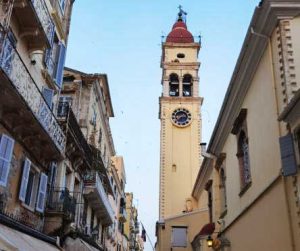
Aqualand
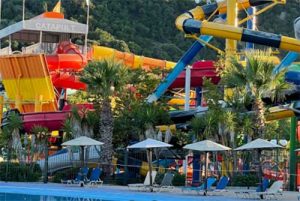
It’s located at Agios Ioannis, to the west of Corfu Town in a beautiful forest setting.
The waterpark opens May to October and there are free sun beds and umbrellas, free changing rooms and showers and good parking.
Theotokou Monastery
The monastery of Moni Theotokou is on Corfu’s west coast near the popular beach resort of Paleokastritsa. Set high on the hillside the 18th century stone-built monastery is one of the most visited tourist attractions on Corfu and a major target of tour buses. The monastery museum is open to the public and has a small tourist shop.
Corfu Walking Trail
Corfu’s long-distance footpath is is about 220 km long and runs the length of Corfu north — south. The trail is clearly way-marked with yellow signs with 11 sections that each take about a day to walk. The best months to follow the trail are early and late in the year and teh terrain varies from mountain mule trails to cliffside paths.
Achillion Palace
This is one of the most impressive buildings on Corfu with exquisite gardens and picturesque views over the Ionian. Located in Gastouri, about 12 km south of Corfu Town, the palace was built in 1890 with the theme of the mythical Greek hero Achilles. It can get very busy in the summer so it’s best visited early in the day.
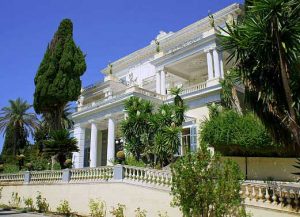
The old and new Castro are worth visiting, as well as St. Spyridon, with the tallest bell tower of the island.
The palace of Ag Michael and Georgiou and the church of Vlahernas are other places of interest.
There is an archaeological museum you definitely should go to if you are interested in ancient history.
Mon Repo
On a property in nature, in Paleopolis, the English commissioner Sir Frederick Adam chose to build his summer residence. The palace that has hosted many blue bloods enjoys a wonderful view of the sea and today hosts the Museum of Paleopolis, while in the wider area there are important archaeological finds.
Monastery of Panagia Paleokastritsa
This historic monastery is located on the northernmost peninsula of Paleokastritsa. As it is built on a cliff, you will enjoy the wonderful sea view.
Angelokastro
As if a divine hand touched it to the top of the rock, Angelokastro is located in one of the most beautiful locations of the island and was built when Corfu belonged to the Despotate of Epirus (1214-1267).
Lake Korissia
In the southwestern part of the island, Lake Korission – characterized as a Natura area – is an important wetland and an attraction for many species of birds. It is offered for hiking from the beach of Halikouna passing between dunes and crossing a cedar forest.
Corfu Museum of Asian Art
In the city, it is the only one in Greece exclusively dedicated to the art and antiquities of Asia. The building where it is housed, the Palace of Saints Michael and George, north of Spianada Square, is an attraction in itself.
Gallery of the Municipality of Corfu
In the east wing of the Palace of Saints Michael and George. Through the collections of painting and engraving, visitors follow the evolution of the arts in Corfu (16th-20th century), while here are also periodic exhibitions of sculpture, art photography and constructions by contemporary artists.
Antivouniotissa Museum
It is housed in an important ecclesiastical monument (from the end of the 15th century), in the church dedicated to the Most Holy Theotokos Kyra Antivouniotissa. The one-room wooden-roofed basilica with a narthex is in itself a reason to visit – especially today it has an important collection of icons and relics by renowned and anonymous artists (15th-20th century), emphasizing the role of Corfu in the development of Greek ecclesiastical painting.
Liston
One of the most cosmopolitan parts of the island, is the building on the west side of Spianada Square. Its name is due to the fact that only the nobles whose names were on the “Libro d’oro” list enjoyed their walk here. Today in its large arched galleries you will find many cafes and restaurants.
Kambielo
The old quarter is considered by many to be the most beautiful in Corfu. Definitely offers the perfect setting for romantic walks on cobbled streets, small picturesque squares with Venetian wells, important churches, mansions and fragrant laundry to complete the setting.
Olive Museum
In the village of Kynopiastes, its purpose is the preservation and promotion of culture through information about the olive and its production. Visitors can see a rich collection of tools and tools as well as photos from the rural life of the last century.
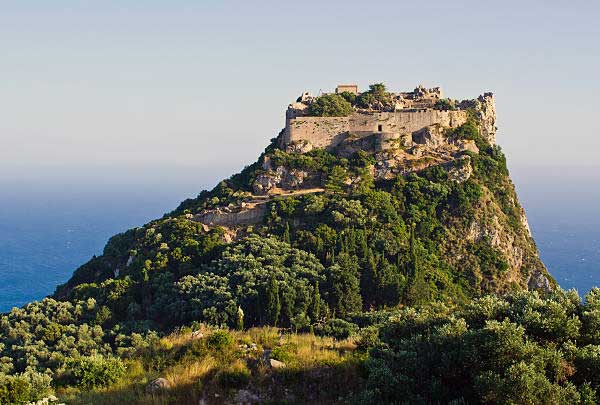
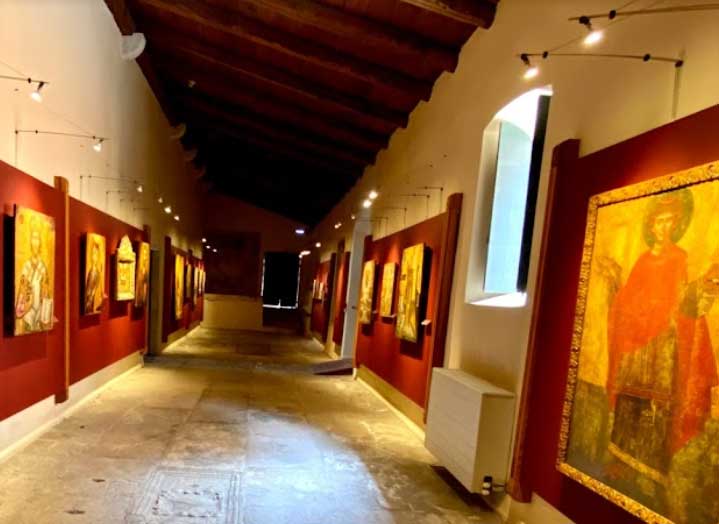
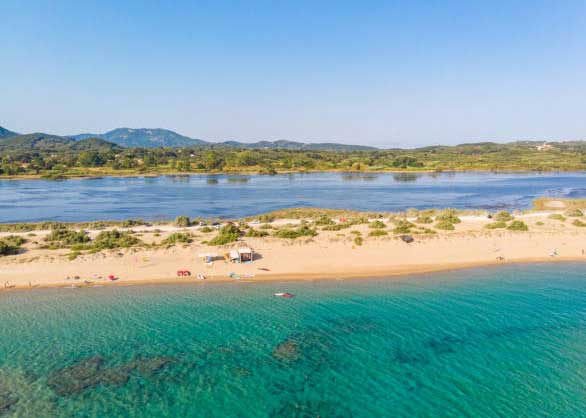
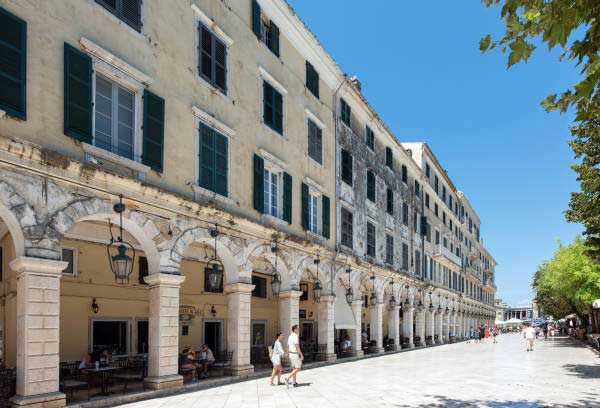
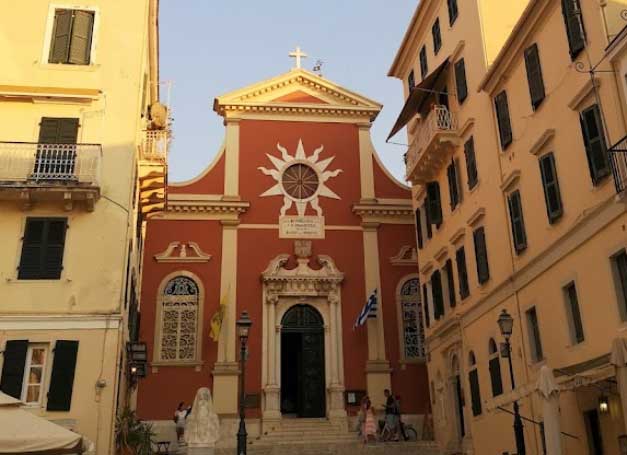
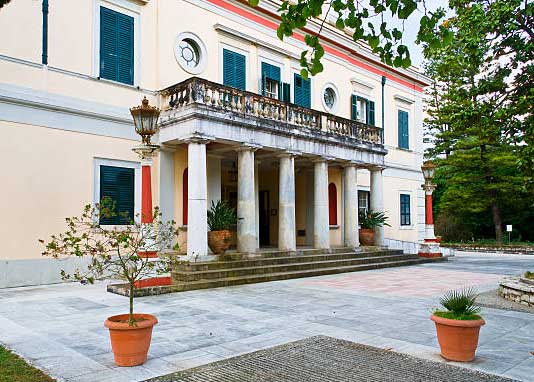
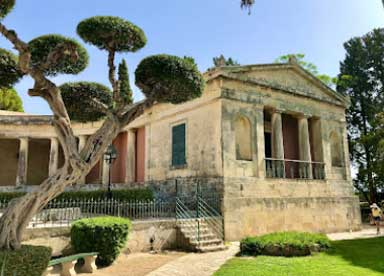
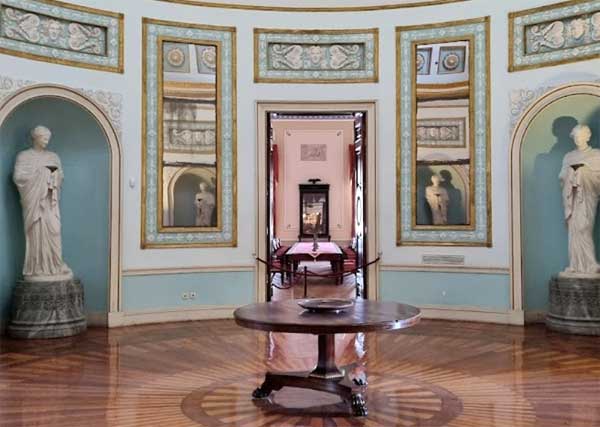
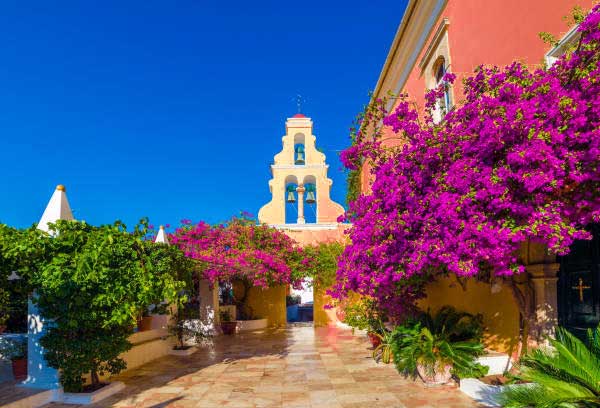
When to go to Corfu ?
When considering a trip to Corfu, the best time will depend on what you’re looking to get out of your visit. Here are some guidelines based on different factors:
Weather in Corfu
May to September: This period offers the best weather for beachgoers and sun seekers. The summer months of July and August can get very hot and are peak tourist times. If you’re looking for sun but fewer crowds, aim for May, June, or September.
October and April: Mild weather and fewer tourists, but sea temperatures might be a bit cooler.
What months are ideal for avoiding the tourist crowds ?
July and August: These are the peak months when tourists, especially from European countries, flock to Corfu. If you want to avoid large crowds, it’s best to avoid these months.
Off-peak months like April, May, and October: There will be fewer tourists, and you might get better deals on accommodation and flights.
Events and Festivals periods
Easter: Corfu is renowned for its unique and grand Easter celebrations. It’s an experience unlike any other, but do expect lots of visitors.
Summer months: Many local villages and towns hold their own panigiria (festivals) celebrating their patron saints, which can be a great cultural experience.
Best time for Nature and Scenery
Spring (April-May): It’s a great time to see Corfu’s countryside in bloom. The island is lush and green, making it ideal for hikes and nature walks.
Autumn (October): The landscape is still relatively green, and you can experience the harvest season, especially for olives.
Best time for budget travel
Off-peak months like April, May, late September, and October are likely to offer better deals on accommodation, flights, and even some attractions.
Best time for water activities
If you’re into water sports or just want to swim, June to September would be best as the sea temperatures are warmer.
Beaches
One of the most popular beach holiday islands in Greece, Corfu is pretty much awash with good beaches. Strangely, some of the most popular are not the best. Dassia and Ypsos, for example, are major holiday favourites despite having relatively poor beaches, although they do benefit from being near Corfu Town. Big sand beaches make their mark on the north coast, notably at popular package resorts of Roda, Paleokastritsa, Benitses, Barbati, Avlaki, Arillas, Agios Ioannis and Sidari. West coast beaches likw Moraitika and Messonghi are quieter but further apart and the further south you go, the wilder they get. The east coast has a clutch of resorts with Kavos a favourite with clubbers.
Read more about the beaches in Corfu
What to do
Water sports are available at many beaches, as well as diving and biking. You can also go horse riding in Ermone and Sidari. In Sidari there are also some really nice tracks for walking.There is an 18 hole golf course. Watch cricket matches in Corfu’s capital or go to the casino. Around the island, especially by the bigger hotels there are tennis courts. A must for the young is the Waterland in Gouvia.
With a Venetian aura, nature-loving, historical and archeological interest, tourist infrastructure, a historic city-jewel but also dozens of traditional villages and the famous Ionian landscape, beautiful beaches with crystal clear waters on a green background, is a separate chapter of Greek and international tourism and attracts a wide range of travelers.
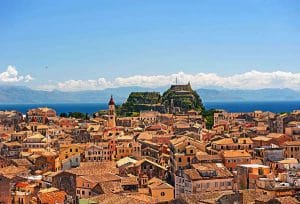
With interesting museums and churches as well as a special cultural tradition, with its philharmonic orchestras. And when it gets dark, the pulse of fun beats in its bars and in the neighborhood in the new fortress.
To the north dominates the mountain of Pantokrator, while the landscape is completed by the villages of the hinterland, both living and abandoned and picturesque fishing villages that have developed into tourist resorts, as well as lagoons with important ecosystems.
Where to stay in Corfu
There is plenty of good accommodation in most of Corfu, except inland and in the less populated south. Rooms can be booked online at all the major resorts. Those escaping the crowds can head inland where villages are untouched by tourism.
Many hotels close down from November to March and it’s not wise to arrive in July or August without advanced reservations. Small hotel owners will still meet incoming ferries with offers of rooms and the Corfu Room Owners’ Association posts a list of hotels and phone numbers at the main esplanade in Corfu Town.
Local cuisine
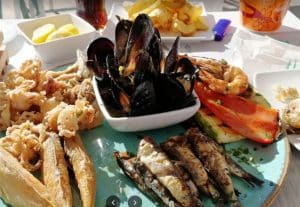
Pasticada, sofrito, bianco and burdetto all have their roots in Italy and today are local specialties that satisfy even the most demanding palates. But the confectionery of Corfu also has a long tradition, such as mandolato, mandolaki, pastaflora, cake with jam, the French mille feille.
The sweets of the spoon made of grapes, figs, but mainly of quince and bergamot, the “fruit glace” with chestnut, the sweet pumpkin pie, made from an orange pumpkin called spurda and pasteli.
The sycomaida, which used to have the place of dessert in the villages of Corfu, made from dried figs, traditional tsitsipira. Locally produced products are olive oil, graviera, Corfu butter, oregano, good wine from the island’s varieties, kumquat, the only fresh beer available in Greece.
During your holiday in Corfu, tasting the typical dishes of Greece and the traditional ones of the island, especially traditional peasant recipes, is a truly unmissable stop.
The cuisine of this island is absolutely delicious. Already starting in the late afternoon, the scent of Greek delicacies spreads in the air that will end up dragging you into one of the many typical taverns of the place.
Obviously it is a Mediterranean-type cuisine, so the main ingredients are fish, meat, oil and vegetables but in these areas there is no lack of goat yogurt, a real passion of the Corfiots!
Also very important for the local tradition are cheeses such as feta, which is used in salads, eaten together with meat or spread on bread and as the seasoned cheese, kefalotiri.
Among the dishes you can taste: the famous Moussaka, the Pasticciàda, a typical dish of Corfu, and the Horiatiki, known to us as the Greek salad.
How to get there
By Air
Corfu is one of the most popular beach holiday islands and charter flights are constant throughout the summer season. The airport of Corfu also has domestic flights to Athens and Thessaloniki but the vast majority of traffic is from Europe.
By ferry
Corfu is also a major port of call for ferries, notably from Italy en route to mainland Patras. Some independent holidaymakers opt for cut-price flight to Italy and a fast ferry to Corfu. Ferries from mainland Igoumenitsa run hourly every day. Read more about Corfu Ferries
Corfu roads
Buses run from the main road in front of the airport to Corfu Town and the journey takes about 15 minutes. Taxis are also parked outside the terminal.
When to go to Corfu
Corfu weather offers typical hot Mediterranean summers. The Corfu holiday season kicks off mid-April as spring temperatures hover around 20°C, with nine hours daily sunshine.
Thermometers rise to 24°C in June and 26°C in August with daily holiday sunshine at 13 hours. Corfu gets very heavy rainfall over the winter (even more than Britain), which helps keep the island green and lush all year roun
Getting around
Better to do it by car, motorbike or quad. The best way to get around Corfu is your own car or rental car. The island is large and the roads are full of often busy curves, especially if you head to the north, for example, to reach Dassia and Barbati.
During the very high season months, namely July and August, the crowding of Corfu translates into difficulty in moving around and availability of parking spaces. In any case, starting from the city center, you can reach all the surrounding towns in a maximum of one hour of travel.
Read more about getting around in Corfu
Climate and weather
The climate of Corfu is maritime Mediterranean, with cool summers and mild winters. Thus, it has approximately the same average annual temperature as Athens, although it is located much further north than Athens.
The coldest month of the year is January and the warmest is August. The annual temperature range reaches 15.7°C. Autumn is much warmer than spring due to the southerly and south-westerly winds and the greater fall recessional action.
The winter is generally mild, but due to the winds of the northern sector, and especially the Bora (coming from the Adriatic), the cold sometimes becomes intense, with the absolute temperature reaching 5°C.
In summer the temperature does not reach high levels and does not exceed 39°C.
The humidity is relatively high: 75 degrees from October to February, 67 degrees from July to August, and 70 degrees during the remaining months.
The cloudiness is small and similar to that of Attica: 3.9 on the 010 scale. Clear days reach 144 per year.
As for the winds, from October to March the south-east prevails, from April to May the south and from June to September the north-west; that is, the meltemias (as in almost the entire Ionian) are presented as north-west winds.
Corfu receives a lot of long-lasting rainfall, with an average annual height of around 1,150 millimeters. This is due to the fact that the island is located west of the mountain trunk
of Greece, which presents great recessionary action and a great frequency of southerly winds during the cold season of the year. The summer drought is significantly limited.
Snowfall is rare and almost the same is true of hail. On the contrary, storms are frequent, especially from October to February, a period in which the Ionian receives more storms than any other region of Greece. Read about the weather in Corfu
Facts about Corfu
Size: 640 sq. km
Population: c. 140 000
Cashmachine: Yes
Internet cafe: Yes
Highest Mountain: Pandokratoras 906m
Airport: Yes
Phone numbers
International code: 0030
Local code: 26610
Hospital: 45811
Taxi: 33811
Police: 30265
Tourist Office: 37520
